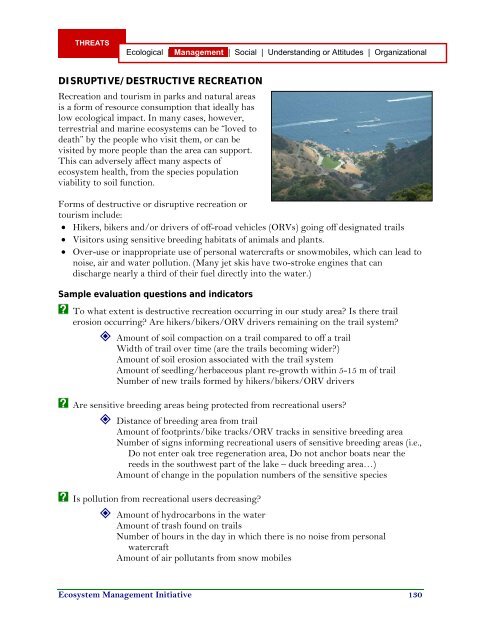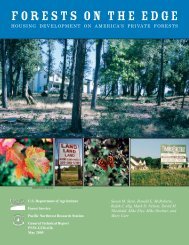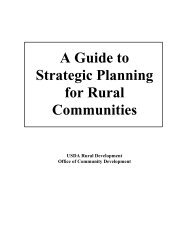Evaluation Sourcebook (.pdf) - School of Natural Resources and ...
Evaluation Sourcebook (.pdf) - School of Natural Resources and ...
Evaluation Sourcebook (.pdf) - School of Natural Resources and ...
- No tags were found...
You also want an ePaper? Increase the reach of your titles
YUMPU automatically turns print PDFs into web optimized ePapers that Google loves.
THREATSEcological | Management | Social | Underst<strong>and</strong>ing or Attitudes | OrganizationalDISRUPTIVE/DESTRUCTIVE RECREATIONRecreation <strong>and</strong> tourism in parks <strong>and</strong> natural areasis a form <strong>of</strong> resource consumption that ideally haslow ecological impact. In many cases, however,terrestrial <strong>and</strong> marine ecosystems can be “loved todeath” by the people who visit them, or can bevisited by more people than the area can support.This can adversely affect many aspects <strong>of</strong>ecosystem health, from the species populationviability to soil function.Forms <strong>of</strong> destructive or disruptive recreation ortourism include:• Hikers, bikers <strong>and</strong>/or drivers <strong>of</strong> <strong>of</strong>f-road vehicles (ORVs) going <strong>of</strong>f designated trails• Visitors using sensitive breeding habitats <strong>of</strong> animals <strong>and</strong> plants.• Over-use or inappropriate use <strong>of</strong> personal watercrafts or snowmobiles, which can lead tonoise, air <strong>and</strong> water pollution. (Many jet skis have two-stroke engines that c<strong>and</strong>ischarge nearly a third <strong>of</strong> their fuel directly into the water.)Sample evaluation questions <strong>and</strong> indicatorsX To what extent is destructive recreation occurring in our study area? Is there trailerosion occurring? Are hikers/bikers/ORV drivers remaining on the trail system? Amount <strong>of</strong> soil compaction on a trail compared to <strong>of</strong>f a trailWidth <strong>of</strong> trail over time (are the trails becoming wider?)Amount <strong>of</strong> soil erosion associated with the trail systemAmount <strong>of</strong> seedling/herbaceous plant re-growth within 5-15 m <strong>of</strong> trailNumber <strong>of</strong> new trails formed by hikers/bikers/ORV driversX Are sensitive breeding areas being protected from recreational users? Distance <strong>of</strong> breeding area from trailAmount <strong>of</strong> footprints/bike tracks/ORV tracks in sensitive breeding areaNumber <strong>of</strong> signs informing recreational users <strong>of</strong> sensitive breeding areas (i.e.,Do not enter oak tree regeneration area, Do not anchor boats near thereeds in the southwest part <strong>of</strong> the lake – duck breeding area…)Amount <strong>of</strong> change in the population numbers <strong>of</strong> the sensitive speciesX Is pollution from recreational users decreasing? Amount <strong>of</strong> hydrocarbons in the waterAmount <strong>of</strong> trash found on trailsNumber <strong>of</strong> hours in the day in which there is no noise from personalwatercraftAmount <strong>of</strong> air pollutants from snow mobilesEcosystem Management Initiative 130






